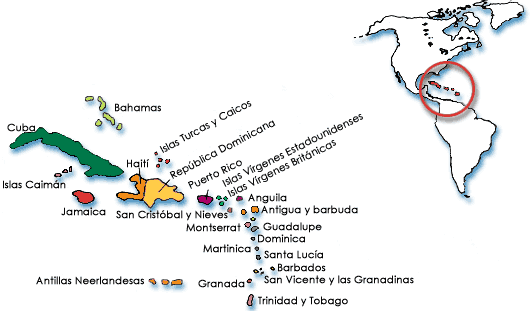
The Caribbean |

|
Cuba
|
Population: 11,265,216 inhabitants
Land surface: 110,860 km2
Currency: Cuban Peso
GDP per capita: US$ 3000
Language: Spanish
Religion: Catholics, 39.6%; Atheist 6.4%; Evangelical 3.3%; Afro Cuban cults
Official name: República de Cuba.
Capital: La Habana 2,189,000 inhabitants (2003).
Other cities (inhabitants – 2000): Santiago de Cuba 534,600; Camagüey 342,900; Holguín 305,000; Guantánamo 264,100; Pinar del Río 172,300.
Government: presidential
Geography. The country of Cuba consists of the island of Cuba, the Island of Youth (formerly Island of Pines) and of 1,600 adjacent cays. Cuba, the largest of the Antilles, has a tropical rainy climate. The country has extensive and fertile plains, with the exception of the southeast, where the heights of the Sierra Maestra. Sugarcane occupies more than 60% of the cultivated land, particularly in the plains of the north. Nickel is the main exportable mineral resource. The Caribbean beaches are exploited for tourism.
|
Haití
|
Population: 9,751,432 inhabitants
Land surface: 27,750 km2
Currency: Gourde
GDP per capita: US$ 1,663
Language: French and Creole
Official name: République d'Haïti (French); Repiblik Dayti (Creole).
Capital: Port Prince (Port-au-Prince)
1,699,000 inhabitants (1999).
Other cities (inhabitants – 2000): Carrefour 356,400; Delmas 301,200; Cap Haitien 119,400
Government: presidential
Religion: Voodoo, syncretism of Christianity and African beliefs; Catholics (80%), Protestants (16%).
Geography. The country occupies the western portion of Española Island, the second largest of the Greater Antilles. There are two major mountain ranges arranged along the east-west direction, delineating the two peninsulas of the north and south. Central Haiti’s topography is composed of basins and elevations. The plains that open towards the sea on the west side are protected from the humid winds by a belt of mountains that spreads across the north and the east. Coffee is the main export.
|
Dominican Republic
|
Population: 9,904,327 inhabitants
Land surface: 48,730 km2
Currency: Dominican Peso
GDP per capita: US$ 8,217
Language: Spanish
Official name: República Dominicana.
Capital: Santo Domingo 1,865,000 inhabitants (2003).
Other cities (inhabitants – 2000): Santiago de Los Caballeros 446,800; La Vega 416,300; San Pedro de Macorís 257,700.
Government: presidential
Religion: There is no official religion. Catholics (91.3%); others (8.7%).
Geography. It occupies the eastern part of the Española Island, and is the second largest of the Antilles. The Cordillera Central crosses the territory from the northwest to the southeast. The fertile Cibao region is located between the central and northern mountain ranges. Sea breezes and ocean currents moderate the tropical rainy climate. Between 1962 and 1980 the country lost a significant fraction of its forested areas.
font-weight:700"> 1. Indicate which country the statement refers to: Cuba, Haiti or Dominican Republic.
®Arturo Ramo García.-Record of intellectual property of Teruel (Spain) No 141, of 29-IX-1999 Plaza Playa de Aro, 3, 1º DO 44002-TERUEL